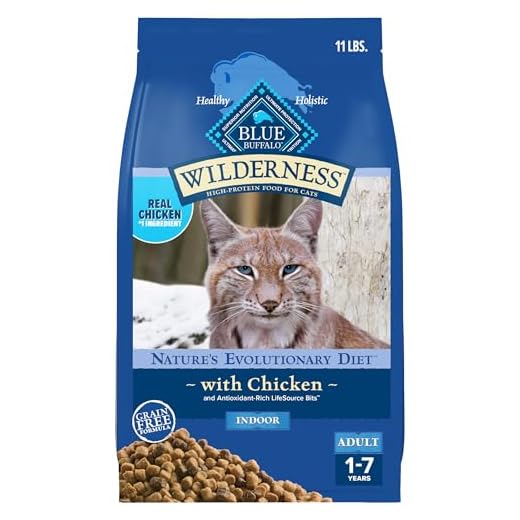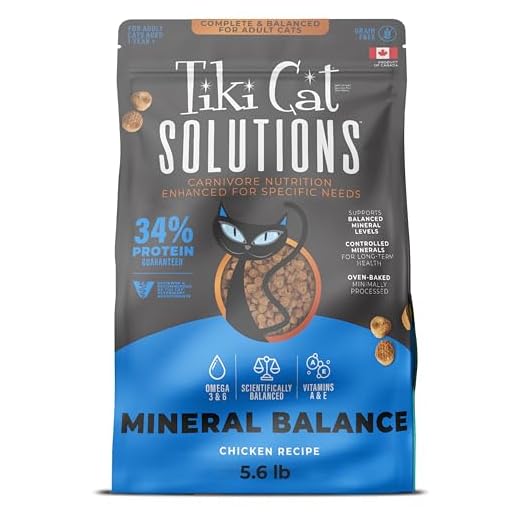



When nausea becomes a regular occurrence, it’s essential to assess dietary habits. Transitioning to high-quality, easily digestible food can make a significant difference. Look for options specifically formulated for sensitive stomachs or those with reduced ingredients.
Next, consider feeding smaller portions more frequently throughout the day. This approach can help alleviate stress on the digestive system and minimize the chance of regurgitation. Always provide fresh water to stay hydrated, as dehydration can worsen health issues.
Monitor for any accompanying symptoms such as lethargy, diarrhea, or changes in appetite. If these signs are present, it’s time to consult a veterinarian for a thorough examination. Regular check-ups can help identify underlying health conditions that may be causing the vomiting.
Keep an eye on grooming habits as well. Frequent hairballs can lead to vomiting, so regular brushing may help reduce fur ingestion. Providing a safe space for play and exercise can also encourage healthy digestion and overall well-being.
By staying proactive and attentive to these factors, the situation may improve significantly. Remember, a happy and healthy lifestyle contributes to a more pleasant experience for both of us!
Immediate Steps If Your Feline Is Vomiting
First things first, withhold food for about 12 hours. This gives the stomach a chance to settle. After this period, offer small amounts of a bland diet, like boiled chicken or rice. Monitor how your furry friend reacts. If the vomiting continues, cut back on food again and consult a veterinarian.
Hydration Monitoring
Keep an eye on water intake. Dehydration can happen quickly. If I notice my human isn’t drinking enough, I remind them to offer fresh water frequently. If I refuse to drink or vomit after drinking, it’s time to seek professional help.
Identifying Triggers
Observe any patterns. Did I eat something new? Change in routine? Stressful events? Keeping a diary of my habits can help in pinpointing the cause. If a specific food or situation seems to be the culprit, it’s wise to avoid it moving forward.
Identifying Potential Causes of Your Cat’s Vomiting
Monitor food intake closely. Rapid eating can lead to regurgitation. Slow feeders or puzzle bowls may help control the pace. For detailed insights, explore why does my cat puke every time she eats.
Check for hairballs, especially in long-haired varieties. Regular grooming minimizes this issue. If vomiting persists, consider dietary factors. Some brands might not suit your feline’s digestive system. Investigate options like is wellness core a good cat food for better nutrition.
Look for signs of stress. Environmental changes, new pets, or loud noises can trigger gastrointestinal upset. Creating a calm space might alleviate anxiety-related vomiting.
Assess any potential health issues. Conditions ranging from infections to digestive disorders can lead to vomiting. Regular veterinarian visits ensure early detection and treatment.
Lastly, keep track of any other symptoms. Changes in behavior, appetite, or litter box habits provide essential clues. This information is crucial for your vet’s evaluation.
Steps to Take When Your Feline Friend Vomits Frequently
Monitor hydration levels. Ensure fresh water is available at all times. Dehydration can escalate quickly and lead to more serious issues.
Adjust feeding routine. Offer smaller, more frequent meals instead of one or two larger ones. This can help reduce the likelihood of regurgitation.
Consider Dietary Changes
Evaluate food quality. High-quality, easily digestible options may be beneficial. Consult with a veterinarian for recommendations specific to individual needs.
Introduce new foods gradually. Sudden changes can upset the stomach. Mix new food with the current one over several days.
Seek Professional Guidance
Schedule a vet appointment if vomiting persists. A thorough examination can identify underlying health concerns that require attention.
Prepare a detailed history of symptoms. Note the frequency, appearance, and any other behaviors to share with the vet for accurate diagnosis.
When nausea becomes a regular occurrence, it’s essential to assess dietary habits. Transitioning to high-quality, easily digestible food can make a significant difference. Look for options specifically formulated for sensitive stomachs or those with reduced ingredients.
Next, consider feeding smaller portions more frequently throughout the day. This approach can help alleviate stress on the digestive system and minimize the chance of regurgitation. Always provide fresh water to stay hydrated, as dehydration can worsen health issues.
Monitor for any accompanying symptoms such as lethargy, diarrhea, or changes in appetite. If these signs are present, it’s time to consult a veterinarian for a thorough examination. Regular check-ups can help identify underlying health conditions that may be causing the vomiting.
Keep an eye on grooming habits as well. Frequent hairballs can lead to vomiting, so regular brushing may help reduce fur ingestion. Providing a safe space for play and exercise can also encourage healthy digestion and overall well-being.
By staying proactive and attentive to these factors, the situation may improve significantly. Remember, a happy and healthy lifestyle contributes to a more pleasant experience for both of us!
Immediate Steps If Your Feline Is Vomiting
First things first, withhold food for about 12 hours. This gives the stomach a chance to settle. After this period, offer small amounts of a bland diet, like boiled chicken or rice. Monitor how your furry friend reacts. If the vomiting continues, cut back on food again and consult a veterinarian.
Hydration Monitoring
Keep an eye on water intake. Dehydration can happen quickly. If I notice my human isn’t drinking enough, I remind them to offer fresh water frequently. If I refuse to drink or vomit after drinking, it’s time to seek professional help.
Identifying Triggers
Observe any patterns. Did I eat something new? Change in routine? Stressful events? Keeping a diary of my habits can help in pinpointing the cause. If a specific food or situation seems to be the culprit, it’s wise to avoid it moving forward.
Identifying Potential Causes of Your Cat’s Vomiting
Monitor food intake closely. Rapid eating can lead to regurgitation. Slow feeders or puzzle bowls may help control the pace. For detailed insights, explore why does my cat puke every time she eats.
Check for hairballs, especially in long-haired varieties. Regular grooming minimizes this issue. If vomiting persists, consider dietary factors. Some brands might not suit your feline’s digestive system. Investigate options like is wellness core a good cat food for better nutrition.
Look for signs of stress. Environmental changes, new pets, or loud noises can trigger gastrointestinal upset. Creating a calm space might alleviate anxiety-related vomiting.
Assess any potential health issues. Conditions ranging from infections to digestive disorders can lead to vomiting. Regular veterinarian visits ensure early detection and treatment.
Lastly, keep track of any other symptoms. Changes in behavior, appetite, or litter box habits provide essential clues. This information is crucial for your vet’s evaluation.
Steps to Take When Your Feline Friend Vomits Frequently
Monitor hydration levels. Ensure fresh water is available at all times. Dehydration can escalate quickly and lead to more serious issues.
Adjust feeding routine. Offer smaller, more frequent meals instead of one or two larger ones. This can help reduce the likelihood of regurgitation.
Consider Dietary Changes
Evaluate food quality. High-quality, easily digestible options may be beneficial. Consult with a veterinarian for recommendations specific to individual needs.
Introduce new foods gradually. Sudden changes can upset the stomach. Mix new food with the current one over several days.
Seek Professional Guidance
Schedule a vet appointment if vomiting persists. A thorough examination can identify underlying health concerns that require attention.
Prepare a detailed history of symptoms. Note the frequency, appearance, and any other behaviors to share with the vet for accurate diagnosis.
When nausea becomes a regular occurrence, it’s essential to assess dietary habits. Transitioning to high-quality, easily digestible food can make a significant difference. Look for options specifically formulated for sensitive stomachs or those with reduced ingredients.
Next, consider feeding smaller portions more frequently throughout the day. This approach can help alleviate stress on the digestive system and minimize the chance of regurgitation. Always provide fresh water to stay hydrated, as dehydration can worsen health issues.
Monitor for any accompanying symptoms such as lethargy, diarrhea, or changes in appetite. If these signs are present, it’s time to consult a veterinarian for a thorough examination. Regular check-ups can help identify underlying health conditions that may be causing the vomiting.
Keep an eye on grooming habits as well. Frequent hairballs can lead to vomiting, so regular brushing may help reduce fur ingestion. Providing a safe space for play and exercise can also encourage healthy digestion and overall well-being.
By staying proactive and attentive to these factors, the situation may improve significantly. Remember, a happy and healthy lifestyle contributes to a more pleasant experience for both of us!
Immediate Steps If Your Feline Is Vomiting
First things first, withhold food for about 12 hours. This gives the stomach a chance to settle. After this period, offer small amounts of a bland diet, like boiled chicken or rice. Monitor how your furry friend reacts. If the vomiting continues, cut back on food again and consult a veterinarian.
Hydration Monitoring
Keep an eye on water intake. Dehydration can happen quickly. If I notice my human isn’t drinking enough, I remind them to offer fresh water frequently. If I refuse to drink or vomit after drinking, it’s time to seek professional help.
Identifying Triggers
Observe any patterns. Did I eat something new? Change in routine? Stressful events? Keeping a diary of my habits can help in pinpointing the cause. If a specific food or situation seems to be the culprit, it’s wise to avoid it moving forward.
Identifying Potential Causes of Your Cat’s Vomiting
Monitor food intake closely. Rapid eating can lead to regurgitation. Slow feeders or puzzle bowls may help control the pace. For detailed insights, explore why does my cat puke every time she eats.
Check for hairballs, especially in long-haired varieties. Regular grooming minimizes this issue. If vomiting persists, consider dietary factors. Some brands might not suit your feline’s digestive system. Investigate options like is wellness core a good cat food for better nutrition.
Look for signs of stress. Environmental changes, new pets, or loud noises can trigger gastrointestinal upset. Creating a calm space might alleviate anxiety-related vomiting.
Assess any potential health issues. Conditions ranging from infections to digestive disorders can lead to vomiting. Regular veterinarian visits ensure early detection and treatment.
Lastly, keep track of any other symptoms. Changes in behavior, appetite, or litter box habits provide essential clues. This information is crucial for your vet’s evaluation.
Steps to Take When Your Feline Friend Vomits Frequently
Monitor hydration levels. Ensure fresh water is available at all times. Dehydration can escalate quickly and lead to more serious issues.
Adjust feeding routine. Offer smaller, more frequent meals instead of one or two larger ones. This can help reduce the likelihood of regurgitation.
Consider Dietary Changes
Evaluate food quality. High-quality, easily digestible options may be beneficial. Consult with a veterinarian for recommendations specific to individual needs.
Introduce new foods gradually. Sudden changes can upset the stomach. Mix new food with the current one over several days.
Seek Professional Guidance
Schedule a vet appointment if vomiting persists. A thorough examination can identify underlying health concerns that require attention.
Prepare a detailed history of symptoms. Note the frequency, appearance, and any other behaviors to share with the vet for accurate diagnosis.











